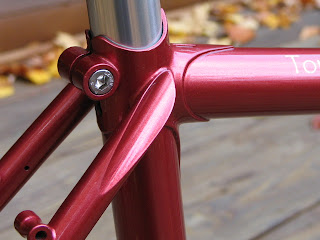 I originally built a low-trail replacement fork for Jay’s Rivendell Canti-Romulus, designed with a 60mm offset that produced about 44mm of trail. Soon after receiving this new fork, Jay telephoned to say that he wanted to commission a new frame, incorporating this fork, if possible. He had some fit issues which could be addressed with a made-to-measure frame. He also had a wish list of small details, including a kickstand plate, which would be easy enough to get just right on a custom frame.
I originally built a low-trail replacement fork for Jay’s Rivendell Canti-Romulus, designed with a 60mm offset that produced about 44mm of trail. Soon after receiving this new fork, Jay telephoned to say that he wanted to commission a new frame, incorporating this fork, if possible. He had some fit issues which could be addressed with a made-to-measure frame. He also had a wish list of small details, including a kickstand plate, which would be easy enough to get just right on a custom frame.No problem. Every frame that I design begins with the fork. There certainly wasn’t anything to prevent Jay’s fork from being recycled, as long as it passed my inspection for damage or misuse.
Jay planned to strip the components from his Romulus to use on this new frame, which would be built with cantilever bosses. Before those rear cantilever bosses had been brazed into place, he sent an e-mail saying that he’d unexpectedly sold the Romulus complete, and would be buying all new components. I pointed out that brake technology now was an open option, and asked if he might like to consider using extra long reach (55-73mm) dual-pivot sidepull caliper brakes. Jay already was familiar with the beautiful “Silver” model from Rivendell, and jumped at the chance to use brakes which would match so nicely with the style of bicycle he envisioned.
But wait … doesn’t the fork have cantilever bosses? It sure did, but those were removed with some very careful hand work with files and sandpaper. No additional heating on the fork blades, and no trace that the canti bosses ever were there. Spoiling the fork’s paint wasn’t a concern since the new frameset was going to be painted in a different color.
So there it is, a second life for a Frame-Neutral Replacement Fork™ and a happy customer with a new bicycle designed to fulfill a dream. That, I propose, is why I do this.
And, finally, a few details, starting with that mounting plate for a fancy Pletscher kickstand.















